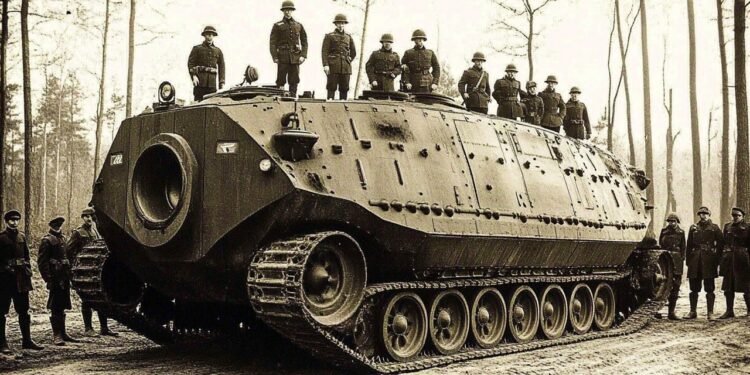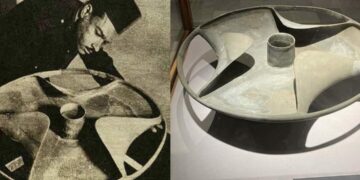Nearly a century has passed since the brutal and inhumane First World War, yet the unconventional combat methods, bizarre weapons, and groundbreaking inventions of that era continue to captivate history enthusiasts. World War I was not just a war of trenches and bayonets; it was a period of intense innovation, where nations raced to outsmart and overpower their enemies with weapons that were as creative as they were deadly. This is the untold story of the Great War’s most astonishing weapons, from flamethrowers and menacing artillery like Big Bertha to silent, suffocating gases like phosgene.
The Fokker Scourge: Revolutionizing Aerial Combat
In 1915, the skies over Europe became a new battlefield. The First World War gave birth to aerial combat, but early pilots struggled with crude methods, throwing grenades, bricks, or even firing pistols at each other. Then, the Germans introduced a game-changing innovation: the Fokker Scourge. Designed by Dutch aviation genius Anthony Fokker, the synchronized machine gun allowed pilots to fire bullets through their propeller blades without shredding them—an engineering marvel that transformed aerial warfare. German fighter planes, like the Fokker Eindecker, dominated the skies, shooting down Allied planes at an alarming rate. British and French soldiers called this period the “Fokker Scourge” because the Germans seemed to own the heavens. This invention forced the Allies to rethink their air strategy, rushing to develop similar technology. For months, the Fokker Scourge gave Germany a deadly advantage, with hundreds of Allied planes falling from the sky, marking it as a ruthless symbol of World War I’s deadly innovation.
Guns and Rifles: The Lifelines of the Trenches
On the ground, firearms underwent groundbreaking transformations. The image of soldiers crouched in muddy trenches, clutching rifles, is iconic for a reason—guns were lifelines, companions, and sometimes the difference between life and death. The Lee-Enfield rifle, the pride of British infantry, could fire 20 to 30 aimed shots per minute in skilled hands, earning the nickname “The Mad Minute” for its reliability in the chaos of trench warfare. The German Gewehr 98, with a deadly accurate range of over 500 yards, made enemies think twice before emerging from their trenches. The Mauser C96, a semi-automatic pistol nicknamed the “broom handle,” gave German officers a compact yet lethal edge. On the American side, the Springfield M1903 and M1917 Enfield rifles were fearsome, favored by snipers and infantry alike. Machine guns, like those used on the first day of the Battle of the Somme, inflicted catastrophic casualties—60,000 British soldiers in a single day. These weapons defined the war with precision, power, and destruction, forming the heartbeat of World War I’s brutal legacy.
Big Bertha: The Colossal Siege Howitzer
Imagine a weapon so powerful its name alone struck fear into enemies. Big Bertha, Germany’s colossal artillery piece, was a symbol of destructive innovation. Developed by the Krupp arms manufacturer, this massive siege howitzer weighed 43 tons and required six vehicles to transport. Unveiled in 1914 during the siege of Liège, Belgium, Big Bertha reduced seemingly impenetrable forts to rubble in days. It could fire 1,800-pound shells over nine miles, obliterating fortifications with brutal efficiency. Soldiers described its deafening roar as earth-shaking, leaving nothing standing. However, its size made it vulnerable—its enormous muzzle flashes and loud blasts revealed its position, and assembly took hours. Big Bertha wasn’t just a weapon; it was a spectacle, a monstrous reminder of World War I’s unforgiving battlefield.
The Maxim Machine Gun: Industrialized Destruction
The Maxim machine gun, developed by Hiram Stevens Maxim in 1884, was the first fully automatic machine gun, capable of firing 500 to 600 rounds per minute—the equivalent of 100 riflemen. Germany’s MG08 variant became a staple of trench warfare, inflicting devastating losses, such as the 21,000 British soldiers killed on the first day of the Somme in 1916. Set up on tripods with water-cooled barrels, the Maxim could fire relentlessly for hours. Its impact was horrifying, mowing down soldiers charging across No Man’s Land. The Maxim was a marvel of engineering but also a chilling symbol of industrialized warfare, earning the grim nickname “weapon of mass production” for its ability to deliver mass destruction.
Zeppelins: Terror from the Skies
Zeppelins, named after Count Ferdinand von Zeppelin, were massive airships that brought terror to World War I. These hydrogen-filled giants, over 600 feet long, carried bombs, reconnaissance equipment, and wireless communication devices. In 1915, Germany launched Zeppelin raids on British cities like London, flying at 10,000 feet—nearly untouchable by early aircraft. Armed with up to 4,400 pounds of bombs, they targeted factories, docks, and civilian homes. By 1916, British planes with incendiary bullets began shooting them down, turning the airships into flaming wreckage. Though their military impact was limited—causing around 500 deaths and 1,300 injuries in Britain—Zeppelins marked a chilling shift, making civilians direct targets and leaving a lasting legacy in aerial warfare.
Artillery: The Silent Killer
Artillery was the unsung hero—or villain—of World War I. Large-caliber cannons, howitzers, and field guns, like the German 77mm field gun, British 18-pounder, and French 75mm, could bombard enemy positions from miles away. Artillery barrages lasted hours orburgo, turning the ground into a wasteland. At Verdun, over 40 million shells caused thousands of casualties in days. Responsible for up to 70% of the war’s casualties, artillery was the heart of trench warfare’s brutal combat.
Type UC-2 Mine-Laying U-Boats: Stealthy Naval Assassins
Beneath the waves, Germany’s Type UC-2 mine-laying U-boats brought stealth and destruction to naval warfare. These submarines could deploy up to 18 mines in enemy shipping lanes, often at night, to avoid detection. The mines floated just below the surface, waiting to explode and sink unsuspecting ships. By the war’s end, UC-2 U-boats had sunk over 200,000 tons of Allied shipping, creating fear and uncertainty on the high seas. These silent assassins proved that subtle innovation could be as deadly as any cannon.
The Mark V Tank: Breaking the Deadlock
In 1916, Britain’s Mark V tank emerged to break the deadlock of trench warfare. This 28-ton steel behemoth, armed with machine guns and cannons, could crush barbed wire, cross trenches, and withstand enemy fire. At the Battle of Cambrai, over 400 Mark V tanks broke through German lines, creating psychological shock among enemy soldiers. Though slow and prone to breakdowns, the Mark V proved armored vehicles could change warfare, setting the stage for modern tanks.
Flamethrowers: Terror in the Trenches
Introduced by Germany in 1915, the flamethrower, invented by Richard Fiedler, was a terrifying weapon. Soldiers carried tanks of gasoline or oil on their backs, spewing flames up to 40 meters to burn enemies in trenches. The psychological impact was immense, creating fear and helplessness as entire trenches were reduced to ruins. The Allies developed their own versions by 1917, using flamethrowers for close-quarter combat. Though not widespread, they left a lasting terror on the battlefield.
Phosgene Gas: The Silent Killer
Phosgene gas, first used by Germany in 1915, was a colorless, odorless chemical weapon that caused lung fluid buildup and suffocation, often hours or days after exposure. Mixed with chlorine gas for surprise, it was responsible for 85% of chemical weapon deaths in the war. Its delayed effects made it particularly horrifying, as soldiers collapsed long after exposure. Protective gear helped, but phosgene’s legacy underscored the chilling reality of chemical warfare.
Barbed Wire: The Deadly Maze
Barbed wire, originally invented for livestock fencing, became a deadly tool in World War I. Stretching across No Man’s Land, it slowed advancing infantry, leaving them vulnerable to gunfire and artillery. At the Somme, poorly cleared barbed wire led to tens of thousands of deaths in hours. It wasn’t just a physical barrier but a psychological weapon, turning the battlefield into a brutal labyrinth.
Camouflage: The Art of Survival
Camouflage emerged as a vital tactic in World War I, pioneered by the French in 1915 under artist Lucian-Victor Guirand. Soldiers wore mottled uniforms, snipers used ghillie suits, and guns and bunkers were hidden with painted nets and foliage. The British used Dazzle camouflage on ships to confuse enemy submarines with bold patterns. Camouflage saved countless lives by making targets harder to find, proving that survival could be an art form.
These weapons—ingenious, ruthless, and devastating—defined the brutal legacy of World War I, forever changing the nature of warfare with their innovation and destruction.























